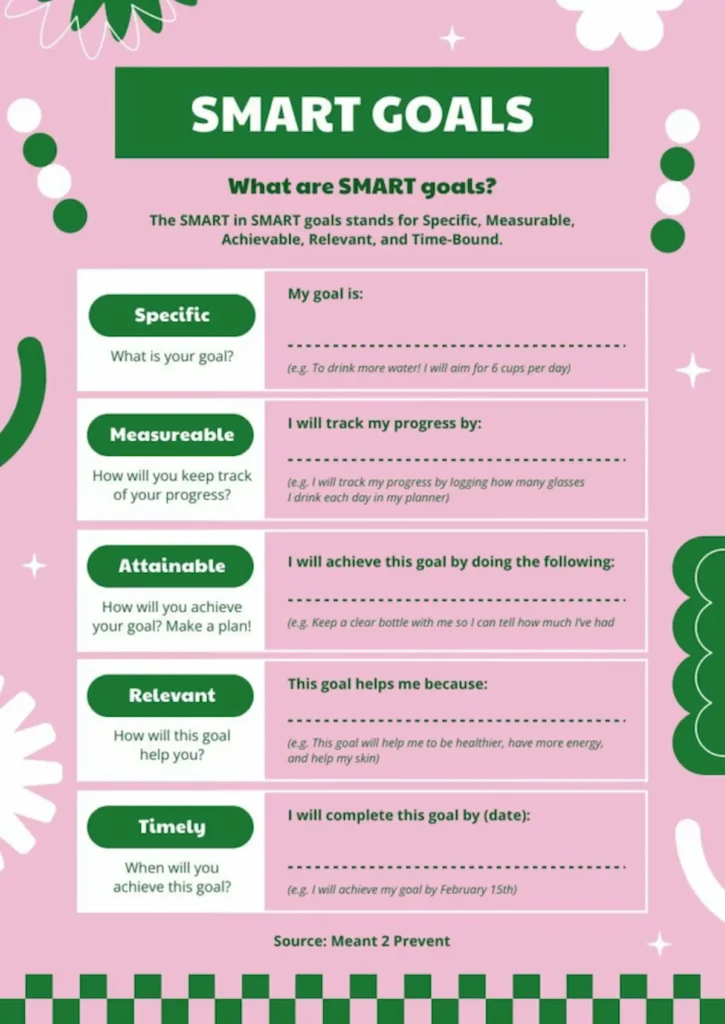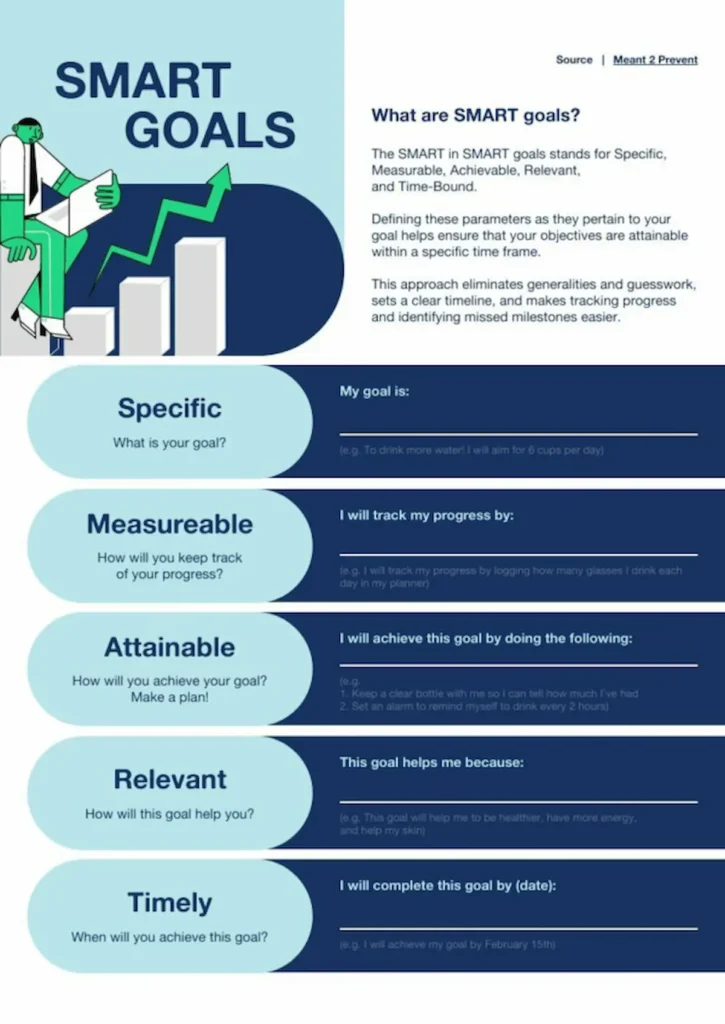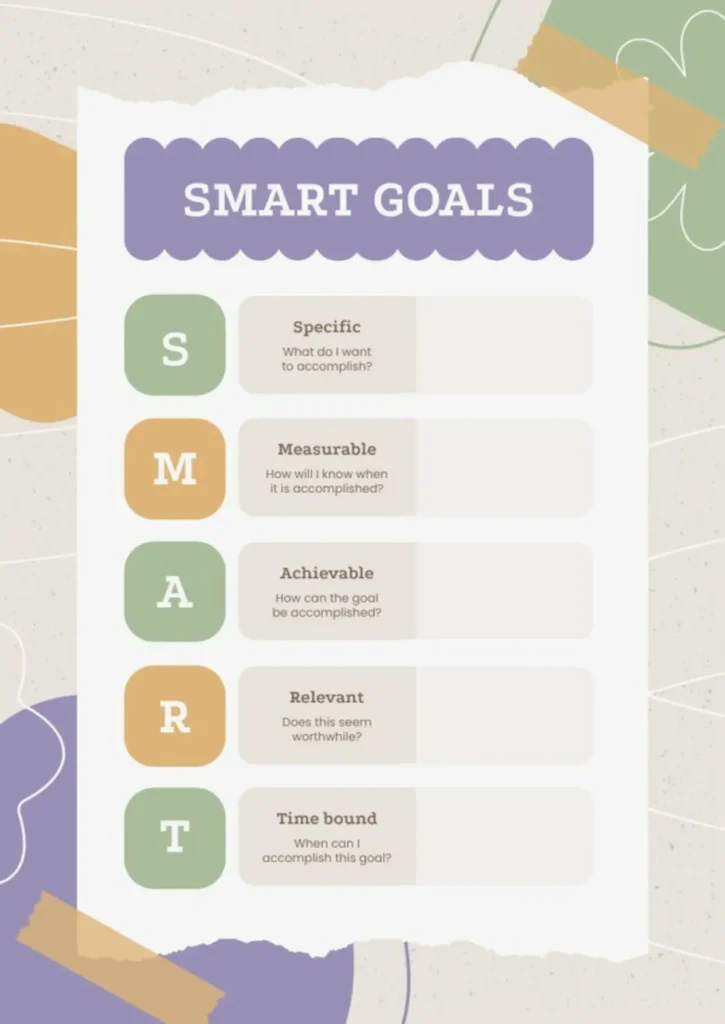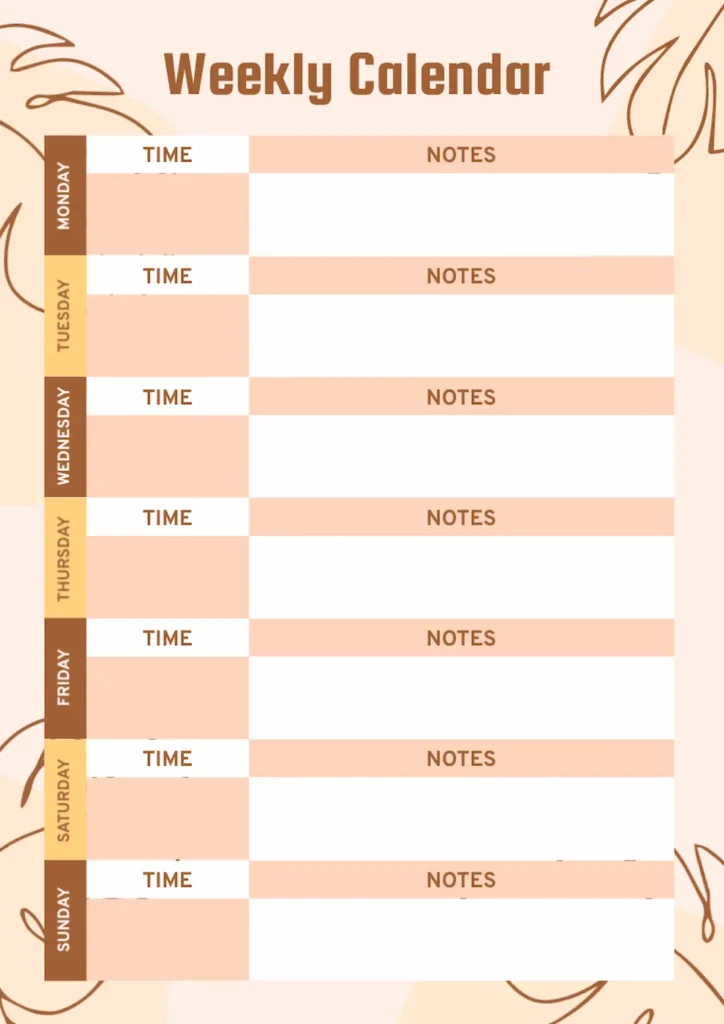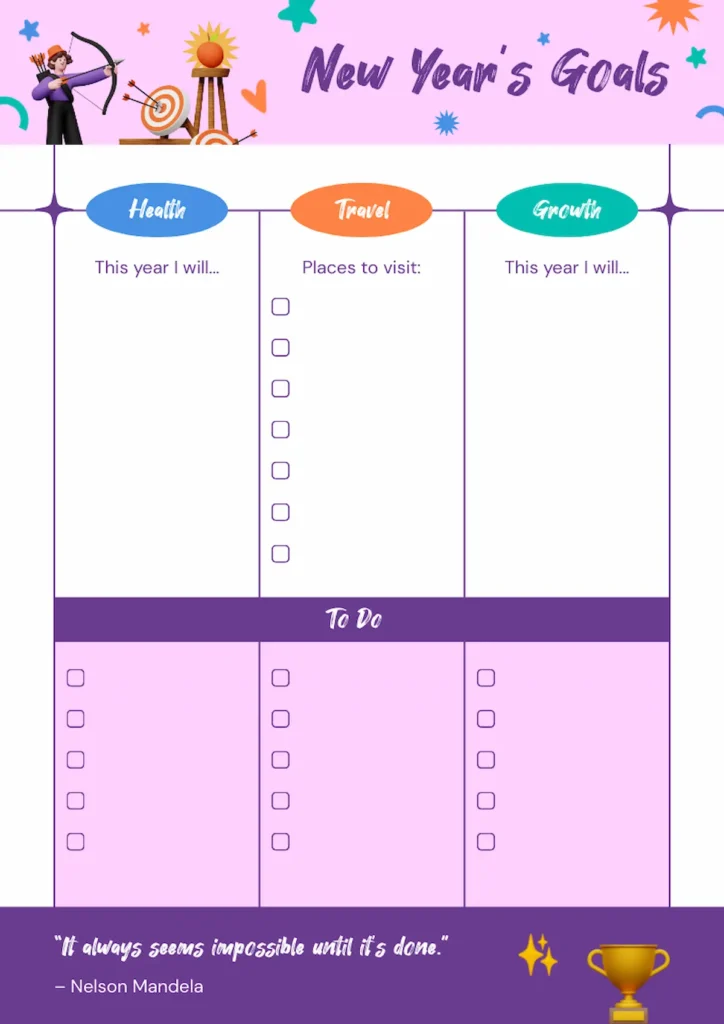We’ve all set up goals that we never reached. Sometimes, we shoot a little too high. Other times, we don’t push hard enough to reach them.This all too common occurrence often comes because we don’t set ourselves up for success.
SMART (specific, measurable, achievable, relevant, and time-bound) goals help you overcome this issue.
We’ve collected a series of real-world SMART goals you can apply across different areas of life and domains. With Piktochart, you can transform your SMART goals into eye-catching visuals, and stay focused and motivated as you work toward achieving them.
Smart objectives examples for professionals and employees
These SMART goals examples will help you sharpen on-the-job performance. For a no-frills tracker that’s ready to fill with your goals, grab this minimalist SMART Goals template.
1. Speed up customer support
“Reduce open support tickets from 120 to 40 per week (-67 %) and shrink first-response time from 18 hours to 6 hours within 60 days by (1) launching an AI triage bot and (2) adding a weekend shift.”
- Specific: The goal states clearly how you plan to speed up customer support.
- Measurable: You can log tickets in queue and first-response time every Friday to track this one.
- Achievable: Off-the-shelf triage bots take only a few hours to configure, and for the staffing all you need is the budget for it.
- Relevant: Faster help means happier customers, higher NPS, and better renewal odds.
- Time-bound: The 60-days time limit keeps it urgent without feeling impossible.
2. Boost presentation skills
“Deliver one client-facing presentation with confidence within 90 days by (1) attending a public-speaking workshop each month and (2) running a weekly five-minute practice session with a peer.”
- Specific: Workshops and weekly practice carve a path towards the goal.
- Measurable: 3 workshops + 12 practice sessions, capped by 1 real presentation.
- Achievable: You won’t need to overhaul your schedule to fit these activities—it should be doable.
- Relevant: Improving at presentations will win you your clients’ trust and, eventually, promotions.
- Time-bound: You are giving yourself 3 months for this, which makes it just challenging enough.
3. Trim unproductive meetings
“Cut average team meeting length from 60 to 40 minutes (-33 %) within the next 8 weeks by (1) enforcing a 4-bullet agenda rule and (2) adopting a “10-minute stand-up” slot for status updates.”
- Specific: A tight agenda plus 10-minutes check-ins keep meetings from swallowing entire mornings.
- Measurable: You just have to track how long your meetings take.
- Achievable: It boils down to two simple behavior tweaks, every team can do this.
- Relevant: Few things drain everyone’s energy more than long meetings.
- Time-bound: 8 weeks might feel long for this one, but it helps the team settle into the new rhythm.
Examples of smart marketing objectives that drive results
These SMART marketing objectives will keep your campaigns focused, measurable, and built for quick wins. This SMART goals planner template is a great companion!
1. Grow your Instagram audience with intention
“Increase Instagram followers by 25 percent, from 10,000 to 12,500, over the next 3 months by posting 5 Reels per week and collaborating with 3 micro-influencers in your niche.”
- Specific: You’re going with two focused tactics: Reels and influencer collabs.
- Measurable: Instagram’s dashboard shows follower growth day by day.
- Achievable: A robust content calendar and a few DMs to creators should get you there.
- Relevant: More followers equals more eyeballs on your brand, and thus more leads.
- Time-bound: Three months suffice to test things out and adjust as you go.
2. Improve email open rates with better subject lines
“Boost your average email open rate from 21 percent to 30 percent within 6 weeks by A/B testing subject lines and sending campaigns only to your most active subscribers.”
- Specific: Better subject lines and smarter segmentation are the levers here.
- Measurable: Every email platform shows open-rate changes after every send.
- Achievable: You already have the tools in place for this, you just need to do the work.
- Relevant: Higher open rates mean more people engaging with your message, lifting every downstream metric.
- Time-bound: Six weeks is plenty of time to run several A/B tests and spot real movement.
Smart goals examples for business growth
With our SMART goals framework template, SMART business goals will make the complex job of scaling your business feel doable.
1. Lift monthly recurring revenue
“Add 20,000 dollars in monthly recurring revenue within the next quarter by introducing a mid-tier pricing plan and upselling 30 existing customers.”
- Specific: You’re setting two specific actions to reach your goal.
- Measurable: Your billing dashboard will keep track of this for you.
- Achievable: Half of the needed lift comes from current customers, so you’re not starting from zero.
- Relevant: More recurring cash smooths cash flow and funds new hires.
- Time-bound: A 90-day sprint keeps the sales team laser-focused.
2. Cut customer churn
“Reduce churn from 6 percent to 4 percent over the next 60 days by rolling out an exit-survey email and offering a 15-minute rescue call to at-risk accounts.”
- Specific: Two churn-fighting tactics: survey insight and live rescue calls.
- Measurable: Churn rate is easy to pull from your subscription platform.
- Achievable: Surveys are automated, and rescue calls fit into existing success reps’ schedules.
- Relevant: Lower churn means higher lifetime value and more predictable growth.
- Time-bound: Sixty days is long enough to spot a trend shift without losing urgency.
3. Enter a new regional market
“Secure ten paying customers in the U.K. within four months by translating the website, running two localized ad campaigns, and partnering with one regional distributor.”
- Specific: Three clear moves: Translate the site, run localized ads, and partner with a regional distributor.
- Measurable: Customer count in the new region sits in your CRM, so that’s taken care of automatically.
- Achievable: Ten customers is a number that marketing and sales can realistically hit when starting from scratch.
- Relevant: New geography diversifies revenue and reduces dependence on one market.
- Time-bound: Four months aligns with one budgeting cycle and lets you evaluate expansion ROI.
Smart goals examples for students and education
Drowning in lectures, labs, and deadlines? These SMART goals give you bite-size steps you can actually squeeze into a packed schedule. Then, keep study progress in sight and style with the aesthetic SMART goals template.
1. Boost semester GPA
“Raise my cumulative GPA from 2.8 to 3.2 this semester by blocking two 90-minute study sessions four days a week and attending every professor’s office hours twice a month.”
- Specific: Both the outlined actions will lead to better grades.
- Measurable: Check your running GPA after each major assignment and the midterm to see if it’s climbing.
- Achievable: Four focused sessions should fit around a typical class schedule (adjust as needed).
- Relevant: A higher GPA opens scholarship and internship doors.
- Time-bound: Your semester is time-bound already so this one was an easy pick.
2. Finish a research paper early
“Complete my 2,500-word history paper one week before the due date by drafting 500 words each Sunday and revising 250 words every Tuesday and Thursday.”
- Specific: You have clear writing quotas and revision days.
- Measurable: You can use your word processor of choice’s word count feature to measure your progress.
- Achievable: Yes, all-nighters have their allure, but spreading the work through six sessions avoids cram stress.
- Relevant: If you complete your paper early you have more time for exam prep.
- Time-bound: You will have your paper ready one week before the due date.
Smart goals examples for teachers and educators
Between grading piles and lesson prep, time can be tight. The objectives below help you streamline classrooms and free up mental space.
Need a ready-made tracker for your SMART goals for school? Grab the weekly calendar template to stay organized and focused!
1. Speed up assignment feedback
“Return graded assignments within 2 days instead of 5 over the next 6 weeks by creating a rubric template and blocking a daily 30-minute grading slot.”
- Specific: A reusable rubric plus a daily grading block cuts turnaround time.
- Measurable: Track average days between submission and return in your LMS.
- Achievable: Thirty minutes a day fits between classes or during prep.
- Relevant: Faster feedback helps students improve before the next unit.
- Time-bound: Six weeks to cement the new routine.
2. Boost class participation
“Raise active participation from 60 percent to 85 percent within 4 weeks by adding a random name picker, using think-pair-share twice per lesson, and awarding small participation points.”
- Specific: This target relies on three engagement tactics: name picker, think-pair-share, and point system.
- Measurable: Record hands-up counts or digital poll responses each class.
- Achievable: Tools are free and require minimal prep.
- Relevant: More voices in discussion deepen understanding for everyone.
- Time-bound: Four-week window keeps energy high.
3. Earn a new certification
“Pass the Google Certified Educator Level 2 exam within 8 weeks by studying 3 hours each weekend and taking one practice test every other Saturday.”
- Specific: Study sessions plus scheduled practice exams.
- Measurable: Track study hours and practice-test scores toward a passing mark.
- Achievable: Weekend blocks avoid weekday crunch.
- Relevant: Certification adds tech skills for the classroom and strengthens your résumé.
- Time-bound: Eight weeks aligns with the next test window.
Attainable goal examples for personal development
Self-improvement often feels vague, but with SMART goals like the ones below you can make it more concrete. For example, visualize your New Year’s resolution with this New Year goals template.
1. Lose weight the healthy way
“Lose 10 pounds in 8 weeks by eating a daily 500-calorie deficit, strength-training three times a week, and walking 30 minutes on non-gym days.”
- Specific: All the actions—calorie tracking, strength session, daily walks—help with the goal
- Measurable: Log each food intake in an app and weigh yourself every Monday, simple.
- Achievable: A 500-calorie deficit and 1.25 pounds per week keep it safe and easy to stick to.
- Relevant: Lower weight improves just about everything in your life, but especially energy and confidence.
- Time-bound: 8 weeks is on the ambitious side for this one, but sticking to the plan keeps the pace healthy and lets you see results fast.
2. Get seven hours of sleep every night
“Be in bed by 10:30 p.m. on weeknights for the next 30 days, aiming for at least seven hours of sleep.”
- Specific: You have to do one thing. Well, two with the sleep duration, but once you’re asleep that should come naturally.
- Measurable: You can write down when you woke up, or use a fancy sleep-tracking app.
- Achievable: You just have to go to bed a little earlier.
- Relevant: It’s hard to find a better performance enhancer than sleep, this is a relevant one for basically the entire planet.
- Time-bound: Thirty days is long enough to turn bedtime into a habit.
3. Start a daily meditation practice
“Meditate 10 minutes every morning for 30 days using a guided app.”
- Specific: You have your tool (the app) and the action (meditation) lined up.
- Measurable: One X on a calendar is enough to track your meditation streak.
- Achievable: You should have ten free minutes somewhere around your 16+ hours days.
- Relevant: Regular meditation reduces stress and improves attention.
- Time-bound: A 30-day streak builds the routine and shows benefits quickly.
How to implement SMART goals the smart way
You can make a goal as SMART as you want, but the smartest goals are the ones you actually reach. That’s the tricky thing about goal setting: you won’t really know if one was good until you’ve either hit it, or abandoned it. Start with these simple strategies to make them stick!
1. Make it personal
SMART objectives are powerful, but they work best when they actually fit you. Anyone can copy an example, but to really follow through, you’ll want to tailor each aim to your own context.
Take the examples in this article as templates, not rules. Tweak them to make them truly yours. The more personal your goal feels, the more likely you are to stick with it.
For example, a widespread aim is to improve fitness by running 5km three times a week. But does it sound like something you want to do?
You may find running boring, or solitary, or too hard on your knees. In those cases, consider switching to attending three spin or Pilates sessions instead. The structure stays SMART, but the method fits you better.
2. Make it visual
Research shows that visual goal tracking may improve motivation and goal pursuit.
The effect is especially strong as you near the finish line. Those visual cues remind you how far you’ve come, and give you a final push to keep going.
Let’s say you’re trying to build the habit of going to the gym three times a week.
You start strong and hit all three sessions in week one. But by week two, your calendar fills up, and suddenly the plan slips. You really meant to go to the gym, but it just got pushed down your mental to-do list.
Now picture a bold tracker on your fridge or a visible weekly schedule by your desk.
At first, it helps you remember the commitment. But by week three, it does more than that. Every time you glance at it, you see your streak: Two workouts down, one to go. It’s a reminder of your effort so far, and a push to finish strong.
Here’s what happens: You glance at your tracker and your brain thinks “Goal time, let’s knock this out” before willpower even enters the picture.
Whether you’re setting career targets or personal milestones, Piktochart’s schedules and planners help you keep track of the milestones you set. Choose a goal template, customize it, and keep it visible. You’ll find it easier to stay committed.
3. Schedule regular reflection times
Beyond tracking daily progress, building in structured reflection times helps you stay aligned with your bigger picture. Set aside 15-20 minutes each week to review what’s working, what isn’t, and what adjustments you need to make. Regular reflection prevents small obstacles from derailing your entire goal and helps you spot patterns in your progress.
Consider using a reflection sheet to make these sessions more productive. A simple framework might include questions like “What did I accomplish this week toward my goal?”, “What challenges did I face?”, and “What will I focus on next week?” It also helps your reflection more focused and ensure that you consistently evaluate your progress and approach.
Quick tips for maintaining motivation
- Break big goals into smaller wins (but not too small, they should still feel significant)
- Celebrate at each milestone you reach
- Keep your targets visible
- Stay flexible as your life situation might change, and so should your goals
- Pair your steps with a habit, for example do a quick stretch or walk right after brushing your teeth or finishing a meeting
Want a deeper dive (and a peek at how we use SMART goals inside Piktochart)? Read our full guide on how to write SMART goals.
FAQ about smart goals examples
What makes a goal truly SMART?
A truly SMART goal is one that adheres to the five core principles of the SMART framework. It’s specific, trackable, realistic, and tied to a clear timeline, which means it’s one you can actually achieve. That way, you know exactly where you’re going and how to get there.
How often should I review my SMART goals?
It depends on the length of the goal. For short-term ones (3 months or less), a check-in every couple of weeks works well. For longer-term ones, once a month is a good rhythm. But if that’s too frequent, aim for at least a quarterly review to stay on track.
Can SMART goals be adjusted over time?
Yes, you can (and should) adjust your SMART goals over time. You may outgrow them, or your situation may change. For example, let’s say you set a target to run 5km three times a week, but you got injured while hiking. Instead of scrapping the plan, you could adjust it to low-impact cardio like cycling or swimming until you’re recovered.


